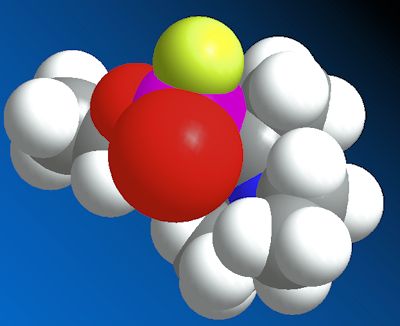
![]()
Novichok
The notorious nerve agent
![]()
![]()
Molecule of the Month August 2018
Also available: HTML version.
![]()
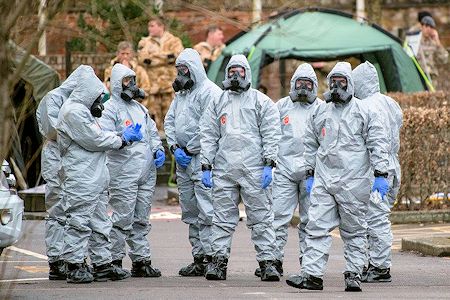
 |
NovichokThe notorious nerve agent
Molecule of the Month August 2018
|
 |
Yes, it’s believed so. The victim was Sergei Skripal, who was a former GRU Russian military officer and British spy who acted as a double agent for MI6 during the 1990s-2000s, before being arrested and sent to a prison colony for treason. As part of a spy-swap arrangement, Sergei moved to the UK in 2010 and became a British citizen. It has been suggested that he became a target for the Russian secret services possibly as a warning to other potential spies.
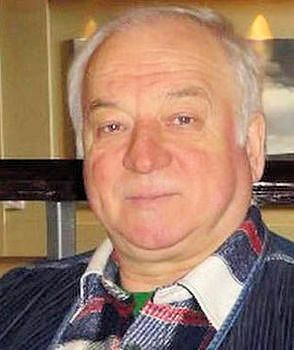 |
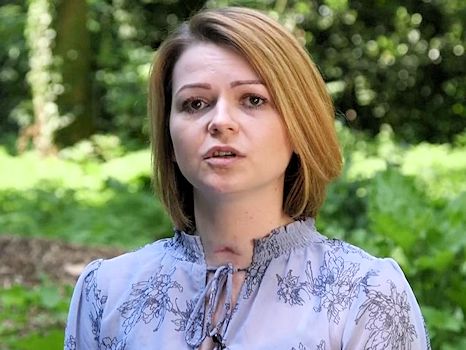 |
| Sergei Skripal, before the attack. | Yulia Skripal, giving a TV interview after surviving the attack. The scar on her neck is from a tracheotomy used to help her breath during her treatment. |
In March 2018, he and his daughter, Yulia (who was visiting him at the time), were found unconscious on a park bench in Salisbury, UK, near where Sergei lived. They were rushed to the local hospital, where their unusual symptoms raised alarms, and tests showed that they had been in contact with a secret nerve agent called ‘Novichok’. Subsequent tests found high concentrations of Novichok on the front-door handle of Yuri’s house, with the implication that it had been placed there deliberately in an attempt to contaminate him. Since Novichok is so deadly, this was effectively an assassination attempt, with the daughter being an innocent victim. Luckily, immediate treatment at the local hospital saved both their lives, although it took 3 months for them both to recover – and even then there remains the risk of some permanent nerve damage. The first police officer to search the Skripal's house, Det. Sgt. Nick Bailey, inadvertantly touched the door-handle and also became gravely ill, but prompt treatment in hospital saved his life too. But the story didn’t end there…

Specialists in hazmat suits inspecting the forensic covering the bench in Salisbury
where the Skripals were found after the nerve agent attack in March 2018
Four months later, 2 more people, Dawn Sturgess and Charlie Rowley, fell ill with identical symptoms in Amesbury, a small town only 7 miles from Salisbury. They were later confirmed to have high concentrations of Novichok on their hands. Neither of these 2 new victims had any apparent link to Russia, and it turns out that Charlie had found a discarded perfume bottle in a recycling bin in Salisbury. Charlie had brought it home, and Dawn then sprayed the contents on her hands, thinking it was a well-known branded perfume. Instead of perfume, it was described as containing an oily liquid which didn't smell of anything much. Charlie got some on his hands too, but crucially, he washed his hands immediately. Dawn did not, and within 15 mins was feeling ill. Although they both were rushed to hospital, sadly, Dawn Sturgess later died, turning an already complicated story into a murder investigation.
Well, the Novichok reagents are reported to have a potency lifetime of up to a year, especially if sealed inside a container. The fact that there might be more discarded bottles of still-active Novichok lying around the streets and parks of Salisbury led to widespread alarm amongst the local population, and accusations from the British Home Secretary, Sajid Javid, that the Russian state was using Britain as a “dumping ground for poison”.
 This must have all caused a massive political argument!
This must have all caused a massive political argument!You could say that! Once it was confirmed that Novichok was to blame, the British government accused Russia of attempted assassination of a British citizen. They announced a series of punishments against Russia, including the expulsion of 23 diplomats. In a show of solidarity with the UK, a large number of countries and other organisations expelled a total of more than 150 Russian diplomats, in what the BBC reported was "the largest collective expulsion of Russian intelligence officers in history”.
Russia claimed to be innocent, and declared the story to be a fabrication and a "grotesque provocation rudely staged by the British and U.S. intelligence agencies" to undermine Russia. They also expelled 23 British diplomats in a tit-for-tat response.
Novichok means ‘newcomer’ in Russian, and was a new type of nerve agent developed secretly in Soviet Russia as a chemical warfare agent in the 1970-1990s.
Ah, the problem with all the older nerve agents like VX and sarin is that they are well known and quite easy to detect. The Novichok agents were secret and designed to be very difficult to detect, so they could be slipped into foreign countries without being discovered. Also, they were made to be so toxic they would defeat the standard NATO hazmat suits of the time. They were also made from unusual chemical reagents – different from the ones used to make the older generation of nerve agents.
The purchase and manufacture of all chemicals that can be used to make dangerous or illicit products, such as warfare agents, deadly poisons, or drugs (such as heroin, cocaine), are closely monitored by the police or intelligence agencies of many countries. So being able to make a nerve agent from chemicals which were not on any watch-list and therefore didn’t raise suspicions was a bonus. Another advantage was that the Novichok agents were relatively safe to handle compared to most other nerve agents.
This was because they were binary munitions, in which two non-toxic (or less-toxic) precursor reagents had to be mixed to produce the active agent. This could be done immediately before use, in, say, a syringe, meaning the assassin was far less likely to poison themselves in the preparations for the ‘mission’.
It’s believed many Novichok agents were developed, all with different structures and characteristics. The Novichok classification refers to the weapon in its binary form (e.g. Novichok-5 or Novichok-7), whereas once synthesised, the agent is known simply by a code number such as A-232. The first of the series to be made was actually part of the ‘V’ series of chemical warfare agents, of which the best known is VX (MOTM July 2001). This new gas, codenamed VR, was actually a binary munition, so became the first of the Novichok series.
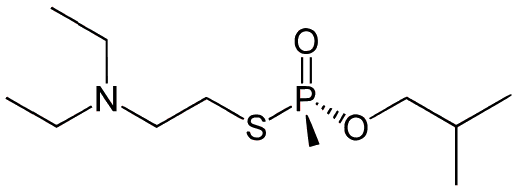 |
|
| VR- the first of the Novichok agents. |
 If they are so secret, how do we know about them?
If they are so secret, how do we know about them?Almost everything we know is due to a Russian defector named Vil Mirzayanov (photo, right). He was an analytical chemist who worked for the Russian State Research Institute of Organic Chemistry and Technology - actually a notorious chemical weapons lab. He didn’t make nerve agents there, but instead his job was to develop methods to detect nerve agents that had been created in the various Soviet chemical weapons facilities in order to monitor the environment around the secret labs for any traces of the agents that might reveal the labs’ true activities to foreign intelligence services. In the 1980s, his analysis showed that the air and water around one of these facilities was being poisoned by leaks of these nerve agents, and threatening the health of the local population. To stop this, he revealed details of the Soviet chemical weapons program to the newspaper Moscow News in 1992. He was immediately arrested for revealing state secrets, and sent to a penal colony. But eventually the case against him was dropped and in 1995 he emigrated to America and wrote a book called “State Secrets: An Insider’s Chronicle of the Russian Chemical Weapons Program”. In this he gave details of the whole Novichok programme.
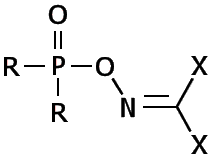 |
| The general formula of a Novichok. R = alkyl, alkoxy, alkylamino, or fluorine and X = a halogen (F, Cl, Br) or CN. |
Despite this, it’s still not known how many nerve agents or their binary Novichok counterparts were actually developed, but it could be as many as several hundred. However, we do know something about their structures. They nearly all are organophosphorus compounds, with various sidegroups attached to change the molecule’s potency or lifetime. These are either in the form of phosphates, or monofluorinated phosphates, or modified versions where the P=O groups are changed to P=Se or P=S.
Often, one of the sidegroups used is phosgene oxime, which is itself a ‘nettle agent’, i.e. it causes chemical burns on exposed skin, as well as rashes and intense itching.
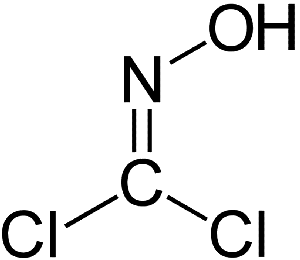 |
|
| Phosgene oxime |
In his book, Mirzayanov explains that one range of compounds was developed based on the phosphorus-oxygen-fluorine core of older nerve agents such as sarin and soman. The O-alkyl group in these compounds was substituted with an amidine group (RC(=NR)NR2) to create a molecule they called A-230. This was 5-8 times more poisonous than VX, and was later adopted as a chemical weapon by the Soviet Army. By changing the sidegroup to a methoxy they then produced A-232 (which was just as toxic but more volatile), and to an ethoxy to make A-234, which was an oily liquid. Once binary formulations were invented to make these compounds at will, the Novichoks were born.
It is believed that the Novichok codenamed A234 was the one used, but it not yet known (or at least it hasn't been revealed) whether the 'perfume' bottle was the container for the previously made Novichok which was somehow smuggled into the country, or the mixing bottle where the two binary counterparts were combined.
On examining the 'perfume' bottle, the police found it had been modified with a special spray nozzle to allow the nerve agent to be sprayed more safely away from the user's hands. They believe this bottle was smuggled through customs at Gatwick airport when the assassins entered the country. After the attack, they then simply discarded it into a recycling bin in Salisbury, still half-full of Novichok, where Charlie Rowley discovered it. You say 'they' - are the attackers known?On 5th September 2018 the UK government revealed that the police investigation had come up with two prime suspects, who had been seen on CCTV around the area of the Skripal's house. The 2 suspects entered the UK on Russian passports using the names Alexander Petrov and Ruslan Boshirov, had stayed in a London hotel for two days, visited Salisbury briefly, and then returned to Moscow. Minute traces of Novichok were also found in the London hotel where they had stayed. The UK Prime Minister, Teresa May, said the suspects are thought to be officers from Russia's military intelligence service the GRU, and that this showed that the poisoning was "not a rogue operation" and was "almost certainly" approved at a senior level of the Russian state. The two suspects later appeared on Russian TV laughing off the accusations and saying they were just 'tourists' that had travelled all the way from Moscow to Salisbury just to see the 'famous cathedral'. However, CCTV of the cathedral area found no evidence of the two men visiting the cathedral, although they were captured on CCTV near the Skripal's home. In a development in September 2018, one of the men was revealed as actually being a Russian intelligence officer called Colonel Anatoliy Chepiga, and was a decorated veteran of Russian campaigns in Chechnya and Ukraine. And later in October, the second man was named as Dr Alexander Mishkin, a naval medical doctor allegedly recruited by the GRU.
|
 The modified bottle, disguised as a bottle of Nina Ricci Premier Jour perfume. Photo: Metropolitan Police. |
In the nervous system, the molecule acetylcholine is needed to allow nerve impulses to pass from a neuron into a muscle, activating it. But after it has done its job, acetylcholine is then broken down by an enzyme called acetylcholinesterase. Without this breakdown process, the muscles contract continuously or randomly or spasm uncontrollably. The Novichok agents inhibit acetylcholinesterase, so acetylcholine concentrations then increase leading to involuntary contraction or spasm of all the muscles in the body. This eventually causes respiratory and cardiac arrest as the muscles in the heart and diaphragm no longer function properly. Copious fluids also fill the victim's lungs, who eventually dies from either suffocation or heart failure.
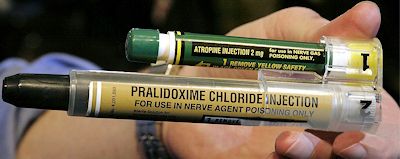 Nasty! How is it treated?
Nasty! How is it treated?The most common treatment is to give the victim atropine, which blocks the acetylcholine receptors and switches off the signal to the overstimulated muscle cells. This is not without risk, however, as atropine is poisonous in high doses, and the dose required to counteract Novichok is close to the lethal amount. Another drug, pralidoxime chloride, is also used to reactivate acetylcholinesterase and relieve the respiratory muscle paralysis, allowing the victim to breathe. During all this treatment, which could take many weeks in intensive care, the victim also has to have their lungs continuously drained of the secretions which would otherwise suffocate them.
Even so, nerve agents need to be countered fast, by speedy administration of these various treatments. The reason is that the agent forms a permanent linkage to the active site of the acetylcholinesterase (this is known as ‘ageing’), after which the antidote will have no effect. The only hope is that the victim has not had too big a dose of the nerve agent, so they can survive long enough for the body to be able to regenerate the acetylcholinesterase naturally over some weeks. This is what seems to have happened to the Skripals.
It's difficult to predict. Even now that the the assassins have been identified, it's doubtful whether they would ever be extradited to the UK to stand trial. Similarly, it's unlikely that definitive proof will ever be found that the Russian government sanctioned the 'hit'. But it remains a worry to Western governments that everything points to the fact that Russia had no concerns about using a chemical warfare agent in a foreign country against a UK citizen, without regard for the implications or safety of the rest of the population. It took probably only a few millilitres of Novichok to render large parts of the town of Salisbury, and later Amesbury, off-limits for several months while they were decontaminated. Police revealed that the recovered perfume bottle contained enough Novichok to potentially kill 'thousands of people', and it had simply been discarded carelessly in a public location. More worrying still, it's believed that around 10 tons of A-234 was manufactured in Russia, and is probably still in storage - somewhere...
Addendum 1: In January 2020 it was announced that the Organisation for the Prohibition of Chemical Weapons (OPCW) will add 5 additional compound families - including the Novichoks - to the list of chemicals tightly restricted under the Chemical Weapons Convention (CWC). Listing them should help to shut down all activity with Novichoks, apart from finding ways to detect them and testing defences such as gas masks and protective clothing. Time will tell...
Addendum 2: On 20th August 2020, Alexei Navalny, a fierce critic of President Putin and the Russian regime, collapsed on a flight in Russia's Siberia region and was rushed to hospital, with symptoms consistent with Novichok poisoning. Two days later, he was transferred to the Charité hospital in the German capital Berlin, and although he was severely ill for several days, eventually recovered. His supporters initially believed his tea had been spiked with Novichok at Tomsk airport but traces of the nerve agent were later found on water bottles at the hotel where he stayed the previous night. In an interview with the German newspaper, Der Spiegel, Mr Navalny said 'the order to use Novichok could only have come from the heads of three of Russia's intelligence services, all of whom work under Vladimir Putin'. Despite Russia's continued use of a weapon of mass destruction against civilians, the response from the West has been rather muted...
Addendum 3: On 21st September 2021, a third man was identified as being involved in the Salisbury Novichok attacks. UK security sources now believe a senior Russian agent, Denis Sergeev, was the on-the-ground commander. All three men belonged to a team from the GRU, Russia's military intelligence service. Despite all the evidence, the Russian Foreign Ministry still deny being involved.
![]()
![]()
![]() Back to Molecule of the Month page. [DOI:10.6084/m9.figshare.7177919]
Back to Molecule of the Month page. [DOI:10.6084/m9.figshare.7177919]